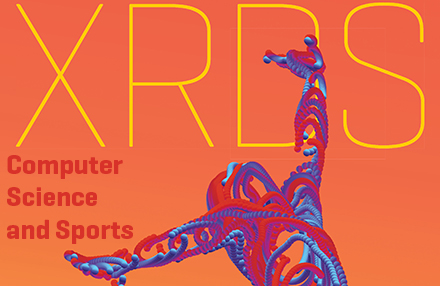Magazine: Summer 2019 | Volume 25, No. 4

More than ever, computer science researchers and practitioners are playing an important role in helping to shape the future of sports as a platform for entertainment, competition, education, and well-being. The application of technology and computer science within the sports world has been powered by the evolution of wearable and portable devices, as well as the ability to comprehend visual and statistical information. It is also important to mention the significant financial investment from media companies to acquire and share data on players, teams, and matches, which has been motivated by the possibility of enriching viewer experience during live sports broadcasts. The relationship between computer science and sports has changed professional basketball, tennis, football, hockey, cricket, and soccer.
Teams and trainers are also using data from matches to improve on-field performance. Technology and artificial intelligence can be beneficial for exploring raw data and building reliable physical and tactical training programs based on the available information. These applications are also in line with the adoption of cameras and video technology for refereeing.
This issue presents the digital evolution of physical competition, covering the historical perspectives of CS applications within sports; how emerging technologies can be used to incentivize not only the practice of sport but also physical activity; how technology can be used to improve experiences for athletes with disabilities; how virtual and augmented reality are circumventing physical and athletic requirements to extend the human body into the realm of “superhuman” sports; and how the impact of eSports has influenced the gaming industry in the past years.
Our aim is to showcase emerging work that represents the dynamic and evolving landscape of computer science and sports, at the personal and professional levels.
Download
- Digital Edition web-based magazine available for subscribers – sign in
- PDF via ACM’s Digital Library
COLUMN: INIT
Computer science and sports: The digital evolution of physical competition
By Patrick Carrington, Eliezer Bernart
SECTION: Features
Health, fun, and engagement: Computing technologies that support physical activity
More and more interactive systems accompany us when we engage in physical activity. But can technologies actually make sports more fun? Or perhaps we will become better at sports through technology?
By Paweł W. Woźniak, Pascal Knierim, Matthias Hoppe
Computing technologies to increase access to physical activity for people with visual impairments
Understanding how to develop technologies that make exercise more accessible to people with visual impairments, particularly in the form of body-based movement and public spaces.
By Kyle Rector
Running Wheel: How an exergame can motivate people to perform repetitive, tedious exercises
Running on a treadmill or cycling on an exercise bike are often monotonous and hard-to-keep habits. Comparatively, social relationships in team sports play an important role to motivate participants. What happens when you combine both activities into one virtual environment?
By Luciana Nedel, Rodrigo Moni, Mateus Nunes
The past, the present, and the future of fitness tracking
The gym of the future will be the quintessence of truly invisible ubiquitous technology that automatically recognizes and tracks the workout progress of each person
By Rushil Khurana
Body-positive computing as a means to counteract normative biases in fitness trackers
Fitness trackers are rigidly defining what it means to be healthy and who "counts" as healthy. Body-positive computing can provide an alternative that allows people to engage with technologies more on their terms.
By Katta Spiel
Superhuman sports --- a testing ground for augmenting our senses
This article reviews recent developments in superhuman sports with regard to extending the human body and augmenting the playing field, and gives an outlook on future research directions.
By Kai Kunze, Stephan Lukosch
Sports and machine learning: How young people can use data from their own bodies to learn about machine learning
In order to foster interest in machine learning among young people, presented are simple and effective ways to engage kids using sensors on their own bodies.
By Abigail Zimmermann-Niefield, R. Benjamin Shapiro, Shaun Kane
Data in motion: Supporting youth interest in athletics through multimodal data analytics
Engagement in STEM learning using athletics and data analytics allows young people to use customizable technological devices to analyze performance.
By Melissa Perez, Stephanie Jones, JaCoya Thompson, Marcelo Worsley
Esports as a catalyst for connected learning: the North America Scholastics Esports Federation
Collegiate esports' rising popularity has created a host of new educational and research opportunities, ranging from understanding and modeling these communities to expanding programs beyond college into high-school learning environments.
By Je Seok Lee, Constance Steinkuehler



















